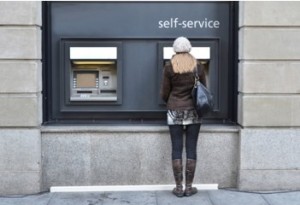The 21st century, unlike any era that came before, is the Age of the Customer. While businesses might have always extolled the idiom “the customer is always right,” now the hackneyed phrase is finally true. Harnessing the power of the Web as well as a bevy of other self-service tools, customers have more power than ever before to pick and choose the products they want and services they support.
As a result, businesses are stepping back and granting customers more and more responsibility. However, should we be celebrating the Age of the Customer, or is it a step backward for customers and economies alike? To answer this question, it is useful to look at all the ways self-service impacts businesses and consumers.
Small Sizes
Self-service stands take up a minimal amount of space, which means the stores and services customers need can squeeze into the cracks to provide quick, close shopping. However, there is a downside to the diminishing size of stores: Lack of space is directly correlated with lack of variety, which means customers may have to visit two or more shops to get all the items they need. In this way, smaller isn’t always better.
Lower Expenses
It costs quite a bit to employ a human; not only does a business pay out regular salaries, but benefits, training, the hiring process, insurance, and more are regular expenses as well. In contrast, a self-service machine is basically a one-and-done payment, with minor maintenance costs every few months. The savings a business incurs usually trickles down to their customers, which means self-service can save everybody money.
Shorter Wait Times
Waiting is usually the bane of any customer’s experience, whether it is at an amusement park or in a frozen yogurt shop. Fortunately, with self-service kiosks, wait time is dwindles to almost zero. While customers with complicated purchases back up the cashier, other customers can happily whiz through the self-service lines. Of course, an experienced cashier may be able to scan faster than an unpracticed proletarian, but the transaction usually feels breezier which is what matters.
Better Information
Though most customers might not realize it, their mobile devices are actually leading the self-service movement. Because customers can (and do) research items and stores online before making purchases, they have access to ratings and reviews that shape how they buy. In response, many stores are helping customers utilize their devices to their full potential with apps that provide more detailed infoon certain products as well as special deals. Thus, self-service is constantly improving.
Less Social Interaction
It is hard to make small talk with a computer. Self-service kiosks certainly strip the human touch from the exchange of goods and money, and that small amount of conversation is a small joy in some customers’ lives. However, few people head to supermarkets and banks for social connection, so business lost due to limited social interaction may be mercifully minimal.
Less Help
Every customer has at one point expected one price while shopping and discovered another while checking out — and more often than not, the second price is the highest. With a self-service machine, it is nearly impossible for a customer to dispute the cost expediently, and many customers will refuse to make a purchase or leave with negative feelings. Human employees can provide better customer service, including information about unexpected fees or sales, which a computer simply cannot do adequately.
Higher Theft
Cashiers do way more than run items over scanners; oftentimes, they are the last person to look over a customer and his or her purchases before he or she leaves the store. When you take away cashiers (or tellers or any human employee) and replace them with robots, you are risking an increase in theft due to a decrease in watchful eyes. While some self-service systems come with security measures, most are not nearly as capable at thwarting shoplifters as a real person.
More Desirable
Most customers already have had some experience with self-service, have endured the drawbacks as well as the benefits, and have found that the conveniences of the practice far outweigh the difficulties. In fact, it is not far off to say that customers absolutely love self-service. Thus, self-service is something that most customers clamor for in all of their favorite stores, from clothing to grocery to food service. Because the customer is always right, most businesses have no choice but to yield to demand — which is likely a giant leap forward into an entirely self-service future.





